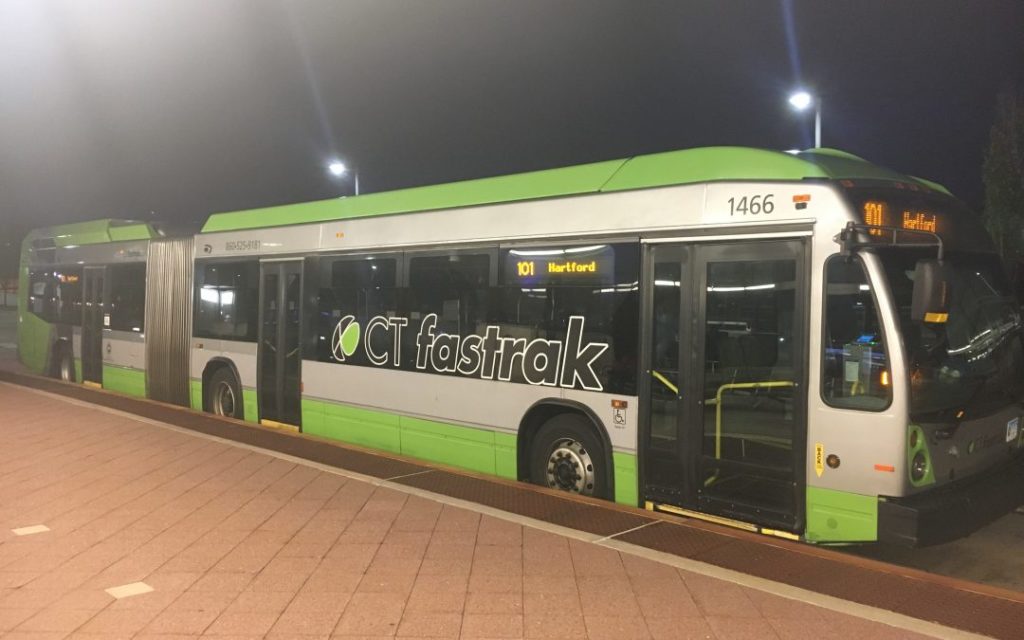
It’s 5 A.M. when I find my way to an empty parking garage in New Britain across the street from CTFastrak’s bus terminal, which is lit up like the Las Vegas strip in the morning darkness. It’s early – earlier than most people have to go to work and, aside from the buses coming and going, the terminal is empty.
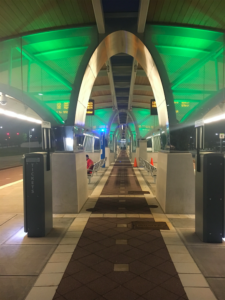
There’s unfinished road construction just outside the terminal in an effort to make access to the bus line a little friendlier. I can’t help but notice the train tracks I cross to reach the terminal which travel alongside the much–maligned CTFastrak route for most of the trip into Hartford.
It’s July 25, the same day that Gov. Dannel Malloy will present the state Bond Commission with a $10 million bond to study tolls on Connecticut’s highways because the State Transportation Fund is running low.
The CTFrastrak bus line is often brought up in the context of Connecticut’s transportation spending. While planning for the dedicated bus route from New Britain to Hartford began in the early 2000’s, Gov. Malloy signed off on the project in 2011, and it was completed in 2015. It offers a direct route from New Britain to downtown Hartford – it has also been an albatross around the neck of the Malloy administration. Politicians and pundits either praise the bus line or deride it as unused – empty buses running back and forth twenty hours a day.
I want to find out if there is any truth to those claims. My original plan was to ride the bus for the entirety of its 20-hour schedule, but my boss limited me to a 12-hour day (something about OSHA).
I purchased a one-day pass for $3 and began riding CTFastrack’s 101 line back and forth from New Britain to Hartford, the original line, for the next 12 hours.
At this early hour, there is no one there, but the buses are running. Not just to Hartford, but to West Farms Mall and UConn Health Center. I board the bus and settle into my seat. I keep count of riders on my computer. At one of the stops, a man is asleep on bus stop bench.
Empty Buses?
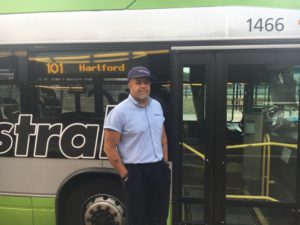
“There’s always someone on the bus,” says CTFastrak driver Mario Donate. He’s been a bus driver for 32 years and been driving CTFastrak since the beginning. For most of the day, he is my guide to the Fastrak world.
At two points during the course of my day, I was the only person on the bus, but in general I had some company. The buses weren’t empty, but they weren’t full either.
Riders got on and off at various stops and I kept track of the number of riders on my computer. Not many rode the whole route from New Britain to Hartford or vice versa. My tally is not scientific, of course, but rather anectdotal for the purposes of this story.
It is July, a month when Connecticut Department of Transportation’s numbers show ridership is about average for the year.
According to the DOT, CTFrastrak had an average of 17,352 weekday passenger trips in July of 2018. Between July 2017 and July 2018, the average weekday trips was 16,050.
At two points during the course of my day, I was the only person on the bus, but in general I had some company. The buses weren’t empty, but they weren’t full either.
However, it should be noted, that is the number of trips, not the number of riders. Presumably, each rider counts as two trips to and from their destination. I technically counted as 20 trips over the course of my day.
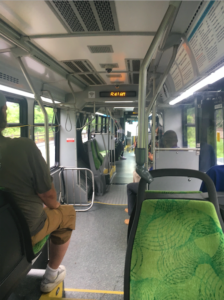
My first ride departed at 5:08 A.M. Between New Britain and Hartford there are ten stops; eighteen people boarded the bus during that trip from stops in Newington, West Hartford and the outskirts of Hartford. The tandem bus holds seventy-five people, and there are three buses running the New Britain to Hartford route at any given time.
The accusation that the buses are empty has been a persistent and often humorous line. Part of it has to do with the cost of the line, part of it politics and general public dissatisfaction with Connecticut’s tax and spend policies.
Another part of it may have to do with the number of buses running constantly in and out of Hartford. In the state’s effort to make CTFastrak a commuter bus so people don’t have to wait for the next ride, it may have more buses running than it could possibly fill.
In general, the bus emptied in Hartford on Main Street. It would then pick people up between Hartford and New Britain. Generally, by the time the bus reached New Britain, they were fairly empty again. Most of the riders depart before the final stop.
Bus driver Dan French says he “wasn’t thrilled with the idea” of Connecticut building the Fastrak line at first, either, but says the buses aren’t empty. “If I just make a drop-off and then you see the bus, it looks empty, but I just had forty people on.”
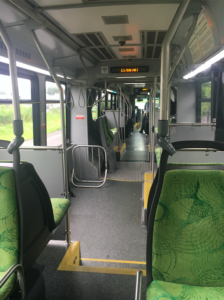
According to my count, ridership was not highest during peak rush hour. In fact, ridership ticked up to 25 and 30 at 11 A.M. The highest ridership I counted that day was 33 people and that was at 1 P.M – not even half of capacity.
Rush hour ridership was fairly low – 18 people during the 8:37 A.M. run starting in New Britain – and 17 during the 5 o’clock run from Hartford.
In total, I counted 365 riders that day who boarded the bus between my first ride at 5:02 A.M. and when I finally pulled into New Britain at 5:29 P.M.
But regular riders – including a friend of mine – say that, at times, the buses can be fairly full for the rush hour commute. My friend works for one of the major insurance companies in Hartford and takes the bus so he doesn’t have to pay for parking (only employees higher up the corporate food chain get free parking in their garage).
During the rush hour run I speak with Ahbi, an information technology specialist who commutes to Hartford on the bus every day. “During rush hour it is packed. Sometimes I have to stand because there’s nowhere left to sit.”
Likewise, John, an employee of the Department of Education, says rumors that no one is riding the bus are “bogus.” Although riding the bus to and from work actually takes longer than driving, John says the bus saves him money on gas and wear and tear on his car.
“I love it,” John said. “I’m impressed.”
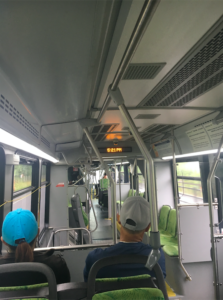
A young woman deigns to take out her ear-buds for a moment to tell me she is taking the bus to a catering job she works in Hartford.
There are others who use the bus line to get around for day-to-day activities — grocery shopping and doctor’s appointments. Riding the bus and listening to the people gives one an overview of the challenges facing some Connecticut residents; it is a cross-section of social, economic, fiscal and transportation issues rolled into one 9-mile route.
One man is taking the bus to a job at the Stop & Shop deli counter in Newington. He worries that he can’t work too much because then he might lose his state medical coverage.
He’s conversing with New Britain resident, Emily, who says she takes the bus every day. She’s also trying to apply for a job at Stop & Shop.
“I take it every day,” Emily says. “Right now, I’m going to West Hartford to get my medications and then I’m going to buy groceries. It comes every ten minutes; what could be more convenient? I don’t have to worry about missing appointments.” Emily buys a 30-day pass every month so she can get around.
Riding the bus and listening to the people gives one an overview of the challenges facing some Connecticut residents; it is a cross-section of social, economic, fiscal and transportation issues rolled into one 9-mile route.
That’s one thing I found about the CTFastrak bus: People who ride the bus, love the bus.
There are also those who attempt to ride the bus for free. They bus-hop up and down the line, never staying on for more than one or two stops in order to avoid the ticket monitors who randomly board to check tickets. I see the same individuals hopping on and off in both directions throughout the day.
They are not going anywhere in particular, they’re just riding the bus.
Throughout the day, my own ticket was checked six different times by bus monitors. At one point, the monitors removed two men who were using expired day passes. Riding the bus without a ticket comes with a hefty $75 fine – one enforced by the State Police and can land the violator in court.
But Mario says the monitors will often give people a second chance before issuing a fine and no ticket was written for the two men removed.
Not Everyone Loves the Bus
While those who use the bus seem to love it, many in the state of Connecticut do not and there may be good reason.
CTFastrak came with a hefty price tag — $570 million. Most of that was covered by the federal government. Connecticut ponied up $113 million in bonded funds to support the project, but its legacy costs highlight another example of Connecticut chasing the all-mighty federal dollar only to saddle itself with another long-term expense.
Sen. Len Fasano, R-North Haven, also points out that part of those federal funds were discretionary and could have been used for other transportation projects in the state. Fasano estimates the New Britain to Hartford line costs taxpayers $95,966 per rider.
As of 2017, CTFastrak cost tax payers $20 million in annual subsidies. The bus line just doesn’t take in enough in ticket sales to cover expenses. With a full day pass costing as much as a gallon of gas, the price might be great for riders but not so great for the state.
While the Malloy administration is quick to note ridership numbers are higher than projected, so are the costs. CTFastrak was originally estimated to cost $10 million per year in state subsidies.
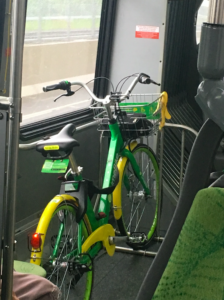
The CTFastrak line has also been extended beyond New Britain to other locations: it now runs regularly to include places like UConn Health, the University of Connecticut, and West Farms Mall.
That increases ridership, naturally, but also increases costs. Mario says that he picks up an extra three hours of overtime per day. There are too many routes and not enough drivers, he says, to cover all CTFastrak’s needs.
Although he regularly works overtime, drivers are limited in what they can pick up. A typical work-shift is nine hours, but the state won’t allow them to work past 12 hours in a day.
Alvin, another CTFastrak bus driver, says he thinks a lack of parking affects ridership and points out an unused lot of cracked, weedy pavement near Kane Street station to make his point. “There’s nowhere for people to park their cars,” Alvin said. “But I don’t think they’re going to want to pay more for Fastrak.”
Alvin is probably right about that – what’s more, the state doesn’t have money to pour into CTFastrak in ways that might make it more convenient for commuters.
Several stations along the New Britain/Hartford route lack adequate parking. The parking garage in New Britain across the street from the terminal is free for CTFastrak riders after CTDOT struck a deal with New Britain. The New Britain terminal also lacks public bathrooms and could probably do with a vendor to sell snacks and drinks and newspapers – but that’s just the opinion of a guy who rode it for 12 straight hours. Most people will be on and off in a half hour.
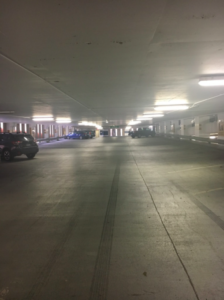
Secondly, the stated goals of the dedicated bus line have yet to come to fruition.
According to Hartford West Major Investment Study which outlined the CTFrastrak project, the bus line was meant to provide more transportation options for residents along the I-84 corridor, lessen traffic congestion on I-84, improve public health and safety, spur economic development and improve quality of life.
The nebulous and vague aspirations of improving public safety and quality of life are difficult to measure. However, the goals of reducing traffic on I-84 and increasing economic development are more concrete and most of that didn’t happen.
Almost four years since completion of the bus line, lawmakers and the governor are saying the state needs highway tolls to help fund highway expansion and reduce traffic congestion in and out the capital.
Those tolls would likely be congestion tolls, which increase or decrease in price depending on traffic conditions and are meant to divert people away from using the highway during peak hours.
According to Hartford West Major Investment Study which outlined the CTFrastrak project, the bus line was meant to provide more transportation options for residents along the I-84 corridor, lessen traffic congestion on I-84, improve public health and safety, spur economic development and improve quality of life.
Supporters of CTFastrak also hoped people and businesses would flock to areas along the route, knowing they had an easy, cheap way to get in and out of the city. Those results are a little more nuanced.
CTFastrak’s Mini-Rust Belt
When dawn finally broke during my bus ride, the view was not pretty.
The New Britain to Hartford line runs right alongside train tracks which isolate a strip of land between the bus line and the Piper and Southbrook Park rivers. The blight begins at Newington Junction and really sinks its teeth in past Flatbush Avenue when the CTFastrak line crosses I-84 carving a strip of land between the bus line and the highway.
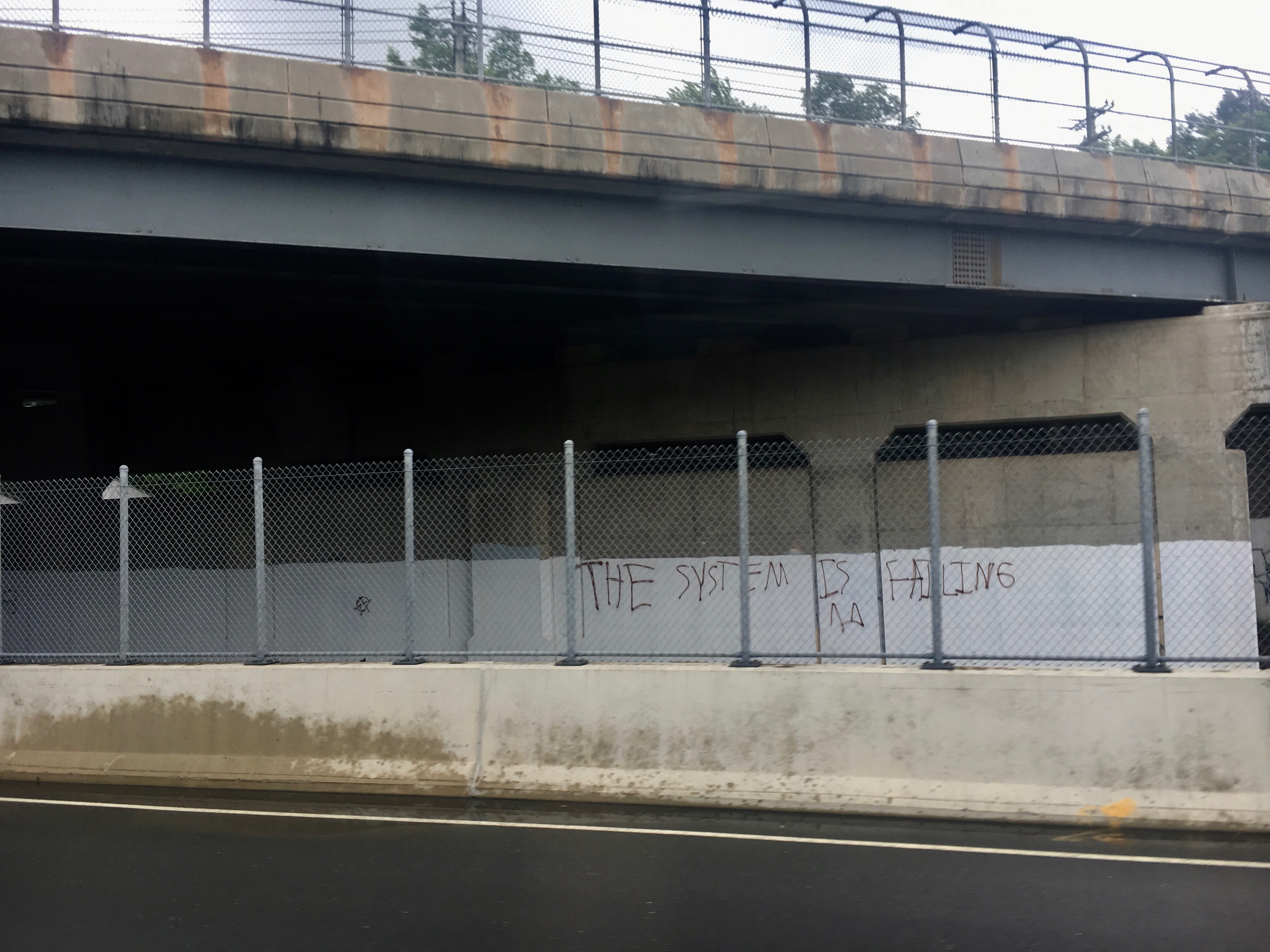
It’s a swath of land whose blight mirrors the rust-belt porn often published in the Washington Post – except this rust belt in the middle of one of the richest states in the nation.
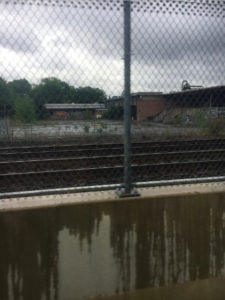
Indeed, the abandoned and crumbling buildings, the graffiti, and strips of broken, unused pavement make the area between Newington Junction and Hartford look like a post-apocalyptic film. Sandwiched between the struggling city of New Britain and the nearly bankrupt city of Hartford, it probably shouldn’t be a surprise. Nevertheless, it remains shocking.
At one point, when it was just another CTFastrak employee and me on the bus, Alvin calls me up front to show me where a highway extension off I-84 ends in a precipitous drop near Kane Street Station. On the other side is the unused lot Alvin would like to see turned into parking.
It’s a section of Connecticut largely unseen by commuters on I-84; it is partially hidden by trees, but from the bus, it is altogether other-worldly, and it continues right into Hartford where the bus passes by a large building on the verge of extinction and suddenly into downtown Hartford.
Just as there is a wrong side of the train tracks, there is the wrong side of the bus line. This mini-rust belt between New Britain and Hartford is on the wrong side of both and it is far more than a bus line could fix.
A study on the impact of CTFastrak on commercial and residential property values surrounding bus stations noted that it was too early to determine whether or not CTFastrak would spurn property value growth.
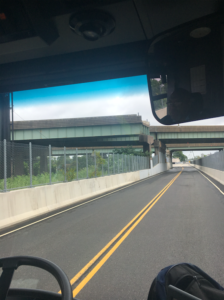
However, the study did show that between 2009 and 2015, there were 1,150 more commercial vacancies near CTFrastrak stations and 3,826 more residential vacancies. This is more likely due to the 2008 recession and Connecticut’s slow economic growth, rather than the bus line. It should also be noted that some of those numbers might be double-counted due to the close proximity of some of the stations and how the study measured vacancies.
That’s not say there has been no bus-related property development. The governor, in 2017, touted the building of a new 54-unit apartment building at 616 New Park, West Hartford near Elmwood Station. The apartment complex was completed this year.
It could take many more years to discern the economic growth spurred by CTFastrak, but that hasn’t stopped Malloy from extolling the virtues of his bus-line legacy. In 2018 the governor said CTFastrak has been “a catalyst toward revitalizing communities” and that “new housing and businesses are popping up along the route.”
Malloy ended the press release by pushing for more transportation funding through highway tolls, an increase in the gas tax and a tire tax.
Malloy has tried to foster economic growth around CTFastrak stations by bonding more money for developments in cities like New Britain, which received $6 million in 2018 to help fund a development across from New Britain’s CTFastrak station called Columbus Commons.
In the End, It’s Just a Bus
For all the inflated praise counterbalanced with the empty bus rhetoric, the CTFastrak bus line remains just a bus like any other. People get on and get off. It’s ridden by the downtrodden and the reasonably well off. Sometimes it’s full and sometimes it’s empty and occasionally a rider will ask for money or take a nap on the bench seats in the back.
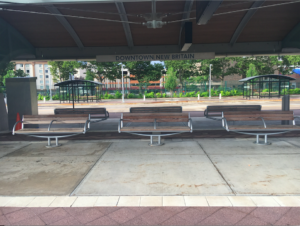
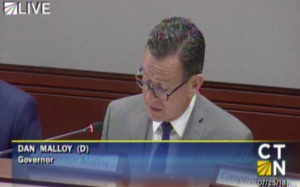
CTFastrak has its qualities: I was able to watch Malloy argue his case for a new $10 million tolls study before the state Bond Commission using CTFastrak’s WiFi system and even finished writing an article on the Commission meeting while riding from Hartford back to New Britain.
With ticket prices so low, I’d consider taking the bus if it didn’t involve a somewhat long commute to the bus station. It might save me some money, but it would also cost me time which I tend to have less and less of these days.
It’s difficult talking with someone like Emily — who has clearly experienced some difficult times and uses the bus every day — to say it was a waste of money. It helps her get to her doctor appointments and hopefully get a job.
But the bus was not and will likely never be the economic booster shot to the region Malloy and others hoped it would be. Government planners love to make mountains out of molehills when they’ve spent mountains of money.
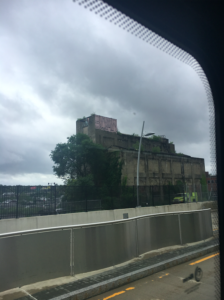
Connecticut has been plagued with a slow economy for ten years and a population that has grown increasingly frustrated with having to pay more to state government to make up for deficits as their friends and neighbors move out of state.
But the belief that building something like a 9-mile bus line would spur economic growth or decrease traffic congestion and start to turn Connecticut around appears more a sign of desperation than solid public policy.
Connecticut is currently suffering from an economic malaise and a fiscal crisis which could stretch on for years. The budget deficits alone are daunting enough. Taxes have climbed steadily upward over the past ten years, but with few — if any — benefits to show for it. Instead, there are calls for more taxes and now highway tolls.
Hopefully, that will change, but it won’t be because of another government investment, taxpayer funded gifts to a major corporation or a feel-good advertising campaign.
Politicians have a desire to say they built something, that they changed things for the better. It is understandable. But the truth is, the problems Connecticut faces are much bigger than a bus – or train, for that matter – can fix.


Chris Powell
November 14, 2018 @ 4:35 pm
Excellent journalism, Marc.
Jason Welch
November 14, 2018 @ 4:38 pm
I second Chris’s comment. Thank you for taking the time.
Steve poulin
November 14, 2018 @ 5:29 pm
Great article!
GJ Gerard
November 14, 2018 @ 6:40 pm
Greatly appreciated. Now please try riding the CT Rail from New Haven to Hartford for a day and provide a report on the boondoggle as well.
Mark Greenstein
November 14, 2018 @ 6:40 pm
It should be a “Carway” until demand for the bus rises.
larry
November 14, 2018 @ 8:11 pm
At the current expense to the State it would better accomplish its goal of less I84 traffic if it was free.
Ken Boudreau
November 14, 2018 @ 9:46 pm
Well done, Mark. Insightful, comprehensive and balanced.
A case can always be made that some people will be well served with government sponsored transportation. The real issue is – at what cost? The taxpayers of this state cannot afford to underwrite projects like this with marginal returns to a handful of people. And the idea of economic development along the busway is yet another one of Malloy’s fanciful pipe dreams.
Joe Markley
November 14, 2018 @ 10:44 pm
It’s worth remembering that there was bus service between New Britain and Hartford before the Busway was constructed, operating on existing roads and accounting for about 10,000 rides a day. The $600 million dollar investment reduced the time for the entire trip by ten minutes and increased ridership by about 50% (according to the best numbers we can get from the state) after an investment of nearly $600 million and at an annual cost of $20 million.
Connie Jagodzinski
November 15, 2018 @ 8:38 am
Excellent journalism. Also excellent remarks. A well-balanced and truthful article with both pros and cons. Well done!
Goodriddance Malloy
November 15, 2018 @ 2:27 pm
thanks for this article. I will think of this tomorrow morning on my expensive, standing room only, non- Wifi Metro North commute.
Michael Sanders
November 16, 2018 @ 8:32 am
Oh, Joe Markley, you still dredge up that fake news about prior ridership? As I’ve told you many times there were about 1400 riders on the old New Britain-Hartford bus route before CTfastrak. That route is still running and still has almost 1000 riders on it to this day since not everyone needs to go someplace that’s walking distance to the CTfastrak stations.
Two minor corrections to the article. The parking structure in New Britain is not new. It has been there for years. The DOT struck a deal with the city for bus riders to park for free in that structure. Cheaper than building a new parking lot.
Also, the train tracks you crossed do not really go straight to Hartford. They go down to Berlin where they meet up with the tracks between New Haven and Hartford.
Otherwise, a good, fair article.
Greg Amy
November 16, 2018 @ 9:54 am
As an initial opponent to the expense (boondoggle), I was primed to reject the busway. However, I took a job in 2016 at a location abutting the line near the Cedar Street station. So the busway caught my attention.
I’ve opened my mind since and used the busway several times. I regularly walk the trail during lunch between the Cedar St and East St stations, and I’ve even used the busway to grab lunch in downtown Hartford. My bros-in-law and I – craft beer fans, all – have snagged the bus in New Britain for a mini-brew crawl to Hartford and back (several craft breweries within an easy walk from the line). And finally, we’ve even caught the busway a few times to go to Yard Goats games and concerts at XFINITY Theatre (nee Meadows Music Theatre); a bit of a hike, but easily do-able.
Am I convinced that it was a cost-effective solution? Not really. I haven’t looked up the numbers but I don’t get the impression from my own limited experience that it’s in any way paying for itself; as one that tends to lean conservative I still think it’s an economic boondoggle.
But do I find it an attractive and convenient solution for forays into Hartford and points in between? Absolutely. It’s there, so I’ll continue to use it where it makes sense. Hell, for $3.50 for an “all-day pass”, why bother with driving and parking?
And, if I ever decide to take another job in downtown Hartford (commuted there from 2003-2013) then it will definitely be on my options list for commuting. But you gotta do something about the parking. Dump the mindset that the busway can replace the door-to-door commute entirely. Make parking at the stations plentiful, make it convenient, and you’ll get many more cars off the highways into and out of Hartford.
Michael Tyrrell
September 23, 2019 @ 4:39 pm
That’s the spirit Greg!… Connecticut once had a strong urban tradition, but most suburbanites are too lazy to get out of their car. They just don’t get it. Systems like Fastrak need to evolve. New development will grow along its corridor while the naysayers -munching on their “Cool Ranch” Doritos, will grow fat in the ass.
Don Pesci
November 16, 2018 @ 12:08 pm
Orwell said the most difficult thing for a writer to do is to see the thing that lies right under his nose. You’ve done it in an entertaining and informative way.
Peter D
November 18, 2018 @ 7:42 am
Great work. Unfortunately, creativity and evidenced based problem solving is not our strong point when it comes to government planners. Often these are classroom ideas that somehow become reality. A classic example of other people’s money. For $125 million the State if Connecticut could have purchased roughly 1,800 Tesla Model S 70 sedans. In a public private partnership with Uber and Lyft employing at least 1,800 if not more. Ridership could have been subsidized for the less fortunate. Finally, with self-driving cars coming online in the next five years many of which may be powered by companies like Tesla, GM and Nissan this is going to make much of the money spent on this seem like a colossal waste.
Phil
May 6, 2019 @ 8:58 am
That’s a classroom idea if I ever heard one!
Red Jahncke
November 29, 2018 @ 9:50 am
Marc — Very well done! Your portrayal is both damning and enchanting. The under-utilization which makes the line such a boondoggle also creates an other-worldly life at a slow un-pressured pace, almost one of languor, which you capture wonderfully. — All Best, Red